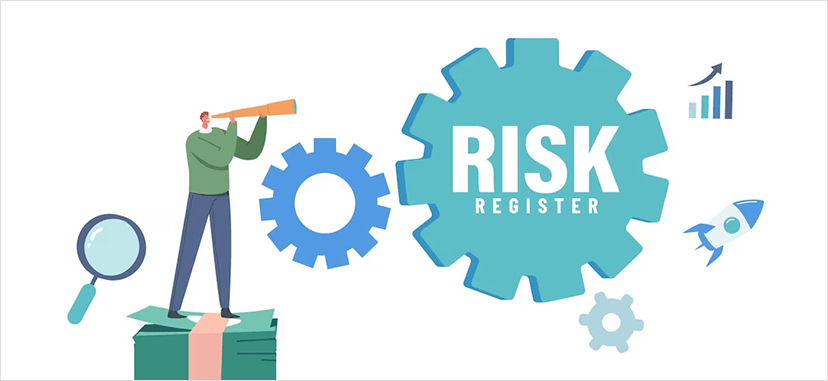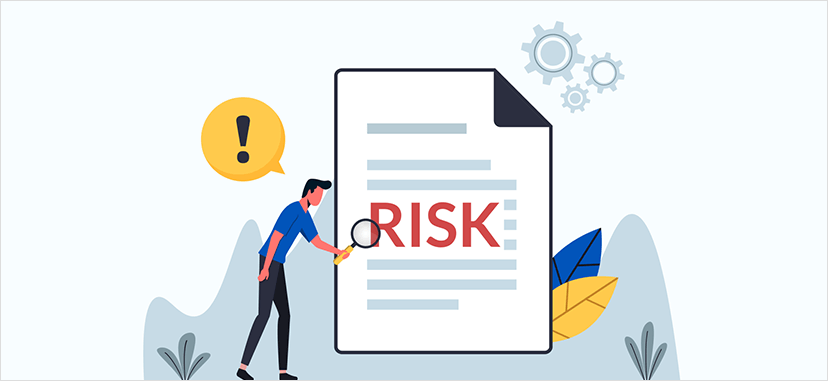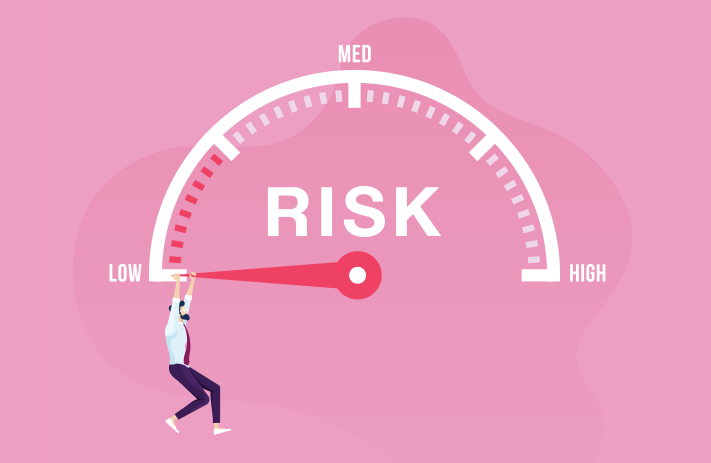
Click the button to start reading
Tackling Project Risks: A Practical Guide to Building Effective Risk Registers
Project management is all about planning, executing, and controlling projects to achieve specific goals, right?
Well, one of the most crucial aspects we need to consider as project managers is managing risks. As you can imagine, uncertainties and unexpected events can sometimes throw our projects off track or even lead to major setbacks.
Now, addressing risks is super important for delivering projects on time, within budget, and with the desired level of quality.
It’s all about helping our project teams spot potential issues early on, determining how much of an impact they could have, and developing strategies to lessen or avoid them altogether. By staying on top of risks, we can minimize the chances of failure and boost our project’s likelihood of success.
This is where the risk register in project management comes in.
This incredibly useful tool helps teams systematically identify, assess, and address potential risks. Think of it as a central hub of information about all the risks your project might face.
It empowers project managers and their teams to make well-informed decisions and control the uncertainties that could impact their projects.
In this article, we’ll dive into everything risk register-related including risk register in project management examples.

What Is A Risk Register?
At its core, a risk register is a document or tool that helps you keep track of all identified risks for a given project.
Picture it as a centralized, living document or tool that captures your project’s identified risks. It’s beneficial because it contains essential information about each risk, such as a brief description, the likelihood of it occurring, the potential impact on the project, and the planned response or mitigation strategy.
In a way, you could see it as a “risk catalog” that helps you stay organized, focused, and in control of your project’s uncertainties.
As for its role in project management, the risk register is indispensable for maintaining a structured and consistent approach to risk management. When you have a clear overview of all the risks, it’s much easier to prioritize which ones need immediate attention, allocate the right resources, and develop well-thought-out strategies to tackle each threat.
Moreover, the risk register informs everyone on the team about potential issues and the steps to address them. It is crucial for fostering transparency, collaboration, and a proactive mindset within the group.

How a Risk Register Can Make Your Life Easier
Let’s dive into the benefits of using a risk register and explore how they can significantly impact your project’s success.
Remember, these advantages aren’t just limited to the ones we’ve listed – there are plenty more out there. But for now, let’s focus on these key benefits and see how they can contribute to effective project management.
Making Smarter Decisions
One of the most significant benefits of using a risk register is that it leads to better decision-making. When you have a comprehensive overview of all potential risks, their probabilities, and impacts, it becomes much easier to decide which risks to prioritize and how to respond to them.
Essentially, the risk register empowers project managers to weigh their options and choose the most effective action.
Boosting Communication and Teamwork
Risk registers also promote open communication and collaboration within the team. With a centralized repository of risks, team members can contribute their insights and expertise, helping identify and address potential issues. This collaborative approach ensures everyone is on the same page and working towards a common goal: managing risks effectively.
Creating Transparency and Fostering Accountability
By maintaining a risk register, you create a transparent and accountable environment where everyone is aware of the potential risks and the steps being taken to manage them. This transparency helps build trust among team members and stakeholders. They can see that the project is being managed proactively and potential issues are being addressed.
Allocating Resources Like a Pro
A risk register helps project managers allocate resources more efficiently. By understanding the likelihood and impact of each risk, you can prioritize which risks need immediate attention and direct your resources accordingly. This ensures that your team focuses on the most critical issues and uses your resources effectively.
Staying Agile in the Face of Risks and Changes
Having a well-maintained risk register allows you to stay agile and adapt quickly to new risks or changes in the project environment. By continuously updating the risk register, you can ensure that your risk response strategies remain relevant and practical, allowing you to navigate uncertainties and keep your project on track.
Lowering the Odds of Project Failure
A comprehensive risk register helps minimize project failure by proactively identifying and addressing potential issues. By staying on top of risks and implementing effective response strategies, you can mitigate their impacts and maintain better control over your project’s success.
Winning Over Stakeholder Confidence
Lastly, a robust risk register can boost stakeholder confidence in your project. By demonstrating that you’re proactively managing risks and being transparent about the steps to address them, stakeholders can trust that you’re committed to delivering a successful project outcome.
The benefits of using a risk register all contribute to a more effective and successful project management process. By leveraging a risk register, you can stay in control of your project’s uncertainties and confidently navigate through challenges.

Who Should Be In Charge of the Risk Register?
So, who should be in charge of creating a risk register?
Well, the truth is, it’s often a collaborative effort that involves multiple stakeholders. While the project manager typically takes the lead in initiating and maintaining the risk register, involving team members, subject matter experts, and other stakeholders is essential throughout the process.
After all, their collective knowledge and expertise can help identify potential risks and develop the most effective strategies to address them.
Now, during the risk identification phase, it’s crucial to have an open line of communication and encourage everyone involved to share their thoughts and concerns. This is where risk workshops, brainstorming sessions, and expert interviews come in handy, as they create a space for everyone to contribute to the risk register.
As the project progresses, the project manager should continuously update the risk register, ensuring that new risks are added, existing risks are reassessed, and responses are adjusted as needed.
It’s also a good idea to regularly share updates with the team and stakeholders, informing them about the current risk landscape and the steps to manage them.
To sum it up, while the project manager plays a central role in creating and maintaining the risk register, it’s really a team effort that benefits from the input and expertise of everyone involved in the project. This collaborative approach leads to a more robust risk register and fosters a risk-aware culture that can significantly contribute to the project’s overall success.

Mastering the Art of Creating an Effective Risk Register
Now that we’ve covered the ins and outs of risk registers and their role in project management let’s dive into some practical tips and insights on creating an effective risk register to set your project up for success.
Getting Started With Successful Risk Register Implementation
The best time to start building your risk register is at the very beginning of your project. By starting early, you can identify potential risks before they become problems and take proactive measures to address them.
Plus, remember to update your risk register continuously throughout your project, as new risks may emerge, and existing ones may change.
Engaging stakeholders in the risk management process is vital. Their input can help you identify risks, assess their potential impact, and develop appropriate response strategies. Be sure to involve stakeholders from various departments and levels within your organization, as this can provide diverse perspectives and insights.
While it’s essential to be thorough when building your risk register, avoid getting lost in excessive detail. Focus on the most significant risks and their potential impacts. Remember that having a manageable list of well-understood risks is better than an overwhelming inventory of every possible issue.
Encouraging Team Collaboration and Communication
Fostering a risk-aware culture within your team is crucial for effective risk management. Encourage open communication about potential risks, promote collaboration, and ensure everyone understands the importance of proactively addressing risks.
To encourage open communication about risks, consider holding regular risk management meetings, creating a dedicated communication channel for risk-related discussions, or using collaborative risk management tools that allow team members to provide input and feedback on risks and response strategies.
Integrating Risk Management into the Overall Project Management Process
For risk management to be truly effective, it must be integrated into the overall project management process.
Align your risk management efforts with your project objectives and stages, ensuring risks are considered and addressed throughout the project lifecycle.
Make risk management a core aspect of your project planning and execution processes. This can include incorporating risk assessments into project milestones, assigning risk owners as part of your project team, and regularly reviewing and updating your risk register to ensure that your risk management efforts remain effective and relevant.
By following these tips and strategies, you’ll be well on your way to creating an effective risk register that will help you manage risks, ensure project success, and build stakeholder confidence.

Examples of Risk Registers in Project Management
Risk registers can be useful in a whole range of industries. We’ve chosen three risk register in project management examples to give you an idea of one in action:
Construction
- Delays in obtaining permits: This risk might have a medium probability and high impact. Response strategies include starting the permit application process early, identifying potential bottlenecks, and maintaining open communication with relevant authorities.
- Unexpected site conditions: This risk might have a low probability but high impact. Response strategies could involve conducting thorough site investigations and assessments, hiring experienced professionals, and developing contingency plans for unexpected discoveries.
- Shortages in labor or materials: This risk might have a medium probability and medium impact. Response strategies include establishing relationships with multiple suppliers, maintaining a buffer stock of critical materials, and developing a flexible workforce plan to adapt to labor shortages.
Software Development
- Changing requirements: This risk could have a high probability and medium impact. Mitigation strategies involve using agile methodologies to accommodate changes, maintaining open communication with stakeholders, and regularly reviewing and updating project scope and requirements.
- Technical debt: This risk might have a medium probability and high impact. Response strategies include dedicating resources to address technical debt, incorporating code reviews and quality control measures, and implementing continuous integration and delivery pipelines to ensure timely and efficient code deployment.
- Resource constraints: This risk could have a medium probability and medium impact. Response strategies involve allocating additional resources to high-priority tasks, cross-training team members, and utilizing external resources, such as freelancers or consultants, when necessary.
Event Planning
- Venue cancellations: This risk might have a low probability but high impact. Response plans could include securing alternative venues, negotiating contract cancellation clauses, and maintaining a list of backup venues meeting the event’s requirements.
- Low attendance: This risk could have a medium probability and medium impact. Response strategies involve increasing marketing efforts, targeting specific audience segments, offering early-bird discounts or incentives, and collaborating with influencers or partners to promote the event.
- Last-minute changes to the schedule: This risk might have a high probability and low impact. Response plans include developing contingency schedules, maintaining open communication with speakers and attendees, and having a dedicated team member handle schedule changes and ensure smooth transitions between sessions.
Developing your risk register should be unique to the threats your business faces. They won’t be the same as another industry, and may not even be the same as a competitor in your industry. Look at what your teams are dealing with and work together on the risk register.

What You Need to Know About Handling Risks
Now that we’ve covered what a risk register is and its benefits, let’s delve into its key components. Understanding the makeup of a risk register works is essential to leveraging its full potential.
In this section, we’ll be discussing the key components of a risk register to help you get started:
Risk Identification
Spotting potential risks early on is crucial because it allows us to proactively address them before they escalate into full-blown issues.
Doing so can save time, money, and resources while minimizing the chances of project delays or failure. It’s all about staying ahead of the curve and being prepared for whatever might come our way.
- Common methods for identifying risks
There are several common methods for identifying risks that you should know about. Some popular ones include reviewing project documents, conducting a SWOT analysis, and performing a risk breakdown structure analysis.These techniques help you uncover potential risks by examining various aspects of your project and considering both internal and external factors. - Brainstorming and risk workshops
These are fantastic ways to unite your team and tap into their collective knowledge and expertise. By organizing brainstorming sessions or risk workshops, you can encourage open discussions about potential risks and their possible impacts on the project. - Expert interviews and historical data analysis
Reaching out to experts in your field or industry can provide invaluable insights into potential risks you might have yet to consider.Similarly, examining historical data from previous projects or industry benchmarks can help you identify common risks and learn from past experiences. It’s all about arming yourself with as much information as possible to make your risk register as comprehensive and effective as possible.
Risk Assessment
After identifying potential risks, the next step is to assess them like a pro.
- Quantitative and qualitative assessment methods
When assessing risks, there are two main approaches: quantitative and qualitative.Quantitative risk assessment uses numerical data to estimate the likelihood and impact of risks. This method is beneficial when you have historical data or industry benchmarks to rely on.On the other hand, qualitative risk assessment is more about tapping into your team’s collective knowledge through expert opinions and discussions. While it might not provide precise numerical values, qualitative assessment is still valuable. It helps you prioritize risks and make informed decisions. - Risk probability and impact
Probability and impact are two more things to consider to assess risks effectively.Probability is the likelihood of a risk occurring, while impact refers to its potential consequences on your project.By evaluating both factors, you can determine the overall severity of each risk and prioritize which ones need immediate attention. Remember, focusing on the most significant risks first will help you allocate resources more efficiently and keep your project on track. - Risk rating matrices and heat maps
Luckily some great tools can make your life easier when visualizing your risk assessment results. A risk rating matrix is a table that displays the risks based on their probability and impact, allowing you to see which ones are most critical at a glance.Heat maps take this concept further by using color-coded grids to visually represent the risk landscape. The combination of colors and positioning makes it easy to spot patterns and prioritize risk response efforts.
Risk Prioritization
Now that we’ve tackled risk identification and assessment, it’s time to prioritize those pesky risks.
- The need for prioritizing risks
Let’s face it, we can’t address all risks simultaneously. Prioritizing risks is about focusing your efforts and resources on the most significant threats to your project.By doing so, you’ll be able to tackle the risks that could have the most substantial impact, ensuring that you’re using your time and resources effectively. In other words, it’s about working smarter, not harder. - Risk scoring and ranking methods
Several methods help you score and rank risks based on their probability and impact. Some popular techniques include the risk score method, the risk matrix, and the risk-adjusted backlog.These methods help you assign a numerical value to each risk, making comparing and prioritizing it easier. By ranking risks based on their scores, you can quickly identify which ones should be addressed first and allocate resources accordingly. - Utilizing risk appetite to prioritize risks
Risk appetite is the level of risk your organization is willing to accept to pursue its objectives. By understanding your organization’s risk appetite, you can prioritize risks that fall outside your comfort zone and require immediate attention.It’s about aligning your risk management efforts with your organization’s strategic goals and ensuring you focus on what truly matters.Handling risks is all about being strategic and making sure you’re spending your time and resources where they’ll make the most significant impact.
Risk Response Planning
Once you’ve identified, assessed, and prioritized risks, it’s time to plan your response. This part of the process is about creating strategies to tackle the threats head-on and minimize their potential impact on your project.
- Strategies for addressing risks
When it comes to responding to risks, there are several strategies you can employ. Some common ones include risk avoidance, mitigation, transfer, and acceptance.Each strategy has its pros and cons, and the best approach depends on the specific risk and your organization’s risk appetite. The key is to choose the correct response for each risk, balancing the potential benefits against the costs and effort involved. - Assigning risk owners
Another essential aspect of risk response planning is assigning risk owners. Risk owners are the individuals or teams responsible for managing and monitoring a specific risk. By allocating a risk owner, you ensure that someone is accountable for each risk, making it less likely that risks will be overlooked or forgotten.It’s all about creating a sense of ownership and responsibility within your team, which can go a long way in ensuring effective risk management. - Developing contingency plans
Last but certainly not least, let’s talk about contingency plans. Contingency plans are your “Plan B” – they outline the steps you’ll take if a risk materializes and starts to impact your project.By creating contingency plans, you’ll be better prepared to respond to threats quickly and effectively, minimizing their potential impact on your project. Remember, it’s always better to have a backup plan in place in case things don’t go as expected.
Monitoring and Control
It’s crucial to keep an eye on how your risk management strategies are working and make adjustments as needed.
- Importance of regular risk review
One thing’s for sure: projects change and evolve, as do the associated risks. That’s why reviewing your risks regularly is essential, ensuring that your risk register stays up-to-date and relevant.Regular risk reviews allow you to identify new threats, reassess existing ones, and evaluate the effectiveness of your risk response strategies. It’s all about staying on top of things and ensuring your risk management efforts remain effective throughout the project lifecycle. - Updating the risk register
As you conduct risk reviews, you’ll likely find that some risks need to be updated, either because their probability or impact has changed or because new information has come to light.Updating your risk register is essential to the monitoring and control process. It ensures that your risk management efforts focus on the most significant threats. Remember, a risk register is a living document, and keeping it up to date is key to its effectiveness. - Risk management reporting and communication
Keeping stakeholders informed about risks and your risk management efforts is critical to ensuring transparency and maintaining their trust. Regular risk management reports can help you communicate key risk-related information to stakeholders, such as changes to the risk register, the status of risk response efforts, and any emerging risks that may require their attention.Open and transparent communication can help build a risk-aware culture within your organization, fostering a proactive mindset that ultimately contributes to project success.
Conclusion
Understanding the concept and value of a risk register can empower you and your team to navigate potential risks with confidence and adaptability.
By embracing a collaborative approach, fostering open communication, and continuously learning from past experiences, you’ll be better equipped to manage risks effectively, leading to greater project success and stakeholder satisfaction.
So, go ahead and embrace the power of risk registers as an essential part of your project management toolkit and experience the difference it can make in steering your projects toward success.
















